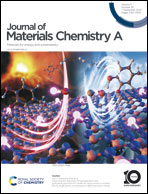CoZnO/C@BCN nanocomposites derived from bimetallic hybrid ZIFs for enhanced electromagnetic wave absorption†
Abstract
Rational design of dielectric–magnetic integrated nanomaterials for meeting impedance matching has been a significant challenge in the field of electromagnetic wave (EMW) absorption. Here, novel zeolitic imidazolate framework (ZIF) derivative-based carbon materials with a rational structure derived from ZIF-L(Zn)/ZIF-L(Co) are prepared to enhance the EMW absorption performance by simple mixing and pyrolysis. Tuning the molar ratio of ZIF-L(Zn) and ZIF-L(Co) can effectively alter the magnetic loss of the CoZnO/C@BCN composite. The metal particles embedded in the boron nitride nanotubes (BCNs) after ZIF-L(Zn) and ZIF-L(Co) pyrolysis reduce the dielectric coefficient, promote effective dispersion of metal particles, and regulate impedance matching. As a result, the CoZnO/C@BCN composite displays excellent EMW absorption with a minimum reflection loss (RL) of −54.9 dB at 6.5 GHz, as well as an effective absorption bandwidth (EAB) of 5.2 GHz (from 12.72 GHz to 17.92 GHz) with an equal absorber thickness of 1.9 mm. The CoZnO/C@BCNs achieve an excellent EMW absorption capacity, which is attributed to the multiple loss mechanisms and outstanding impedance matching. The results provide new insight into MOF-based carbon absorbers with light weight and high performance, which demonstrate significant potential in the treatment of EMW absorption.



 Please wait while we load your content...
Please wait while we load your content...